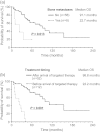Long-term outcomes and prognostic factors in 78 Japanese patients with advanced pancreatic neuroendocrine neoplasms: a single-center retrospective study
- PMID: 26378090
- PMCID: PMC4668751
- DOI: 10.1093/jjco/hyv143
Long-term outcomes and prognostic factors in 78 Japanese patients with advanced pancreatic neuroendocrine neoplasms: a single-center retrospective study
Abstract
Objective: Despite an increase in the number of Japanese patients with pancreatic neuroendocrine neoplasms, long-term outcomes and prognostic factors, especially for those with advanced disease, remain unclear.
Methods: We retrospectively reviewed the medical records of 78 patients with unresectable pancreatic neuroendocrine neoplasms treated at our hospital from January 1987 to March 2015. Survival analyses were performed using Kaplan-Meier methods. Prognostic significance of several clinicopathological factors were analyzed by univariate and multivariate analyses using a Cox regression model.
Results: Median overall survivals of pancreatic neuroendocrine tumor (n = 64) and pancreatic neuroendocrine carcinoma (n = 14) were 83.7 and 9.1 months, respectively (hazard ratio: 0.02, 95% confidence interval: 0.01-0.08, P < 0.001). Although no significant differences were observed using a Ki-67 cut-off value of 2% (hazard ratio: 0.46, 95% confidence interval: 0.16-1.13, P = 0.0989), a Ki-67 cut-off of 10% was a significant predictor in patients with pancreatic neuroendocrine tumor (hazard ratio: 9.95, 95% confidence interval, 3.01-32.97, P < 0.001). Treatment after the advent of targeted therapy (hazard ratio: 0.07, 95% confidence interval: 0.03-0.19, P < 0.001) and the presence of bone metastases (hazard ratio: 4.38, 95% confidence interval: 1.42-11.29, P = 0.013) were significant prognostic factors in patients with pancreatic neuroendocrine tumor evaluated by univariate analysis. Multivariate analysis also revealed that a Ki-67 index ≥10% (hazard ratio: 38.8, 95% confidence interval: 8.42-226.62, P < 0.001), approval of targeted therapy (hazard ratio: 0.02, 95% confidence interval: 0.00-0.11, P < 0.001) and bone metastases (hazard ratio: 5.56, 95% confidence interval: 1.10-24.00, P = 0.039) were independent prognostic factors.
Conclusions: We elucidated the long-term outcomes and prognostic factors in Japanese patients with advanced pancreatic neuroendocrine neoplasms.
Keywords: Ki-67 index; pancreatic neuroendocrine carcinoma; pancreatic neuroendocrine neoplasms; pancreatic neuroendocrine tumor; prognostic factor.
© The Author 2015. Published by Oxford University Press. All rights reserved. For Permissions, please email: journals.permissions@oup.com.
Figures


References
-
- Ito T, Igarashi H, Nakamura K, et al. Epidemiological trends of pancreatic and gastrointestinal neuroendocrine tumors in Japan: a nationwide survey analysis. J Gastroenterol 2015;50:58–64. - PubMed
-
- Yao JC, Hassan M, Phan A, et al. One hundred years after ‘carcinoid’: epidemiology of and prognostic factors for neuroendocrine tumors in 35,825 cases in the United States. J Clin Oncol 2008;26:3063–72. - PubMed
-
- Modlin IM, Lye KD, Kidd M. A 5-decade analysis of 13,715 carcinoid tumors. Cancer 2003;97:934–59. - PubMed
Publication types
MeSH terms
Substances
LinkOut - more resources
Full Text Sources
Other Literature Sources
Medical

